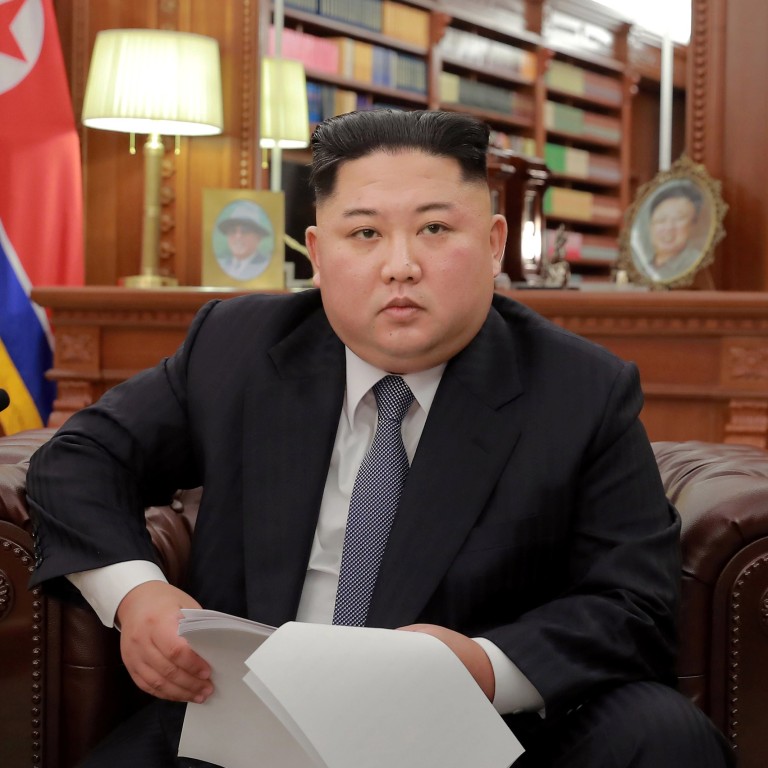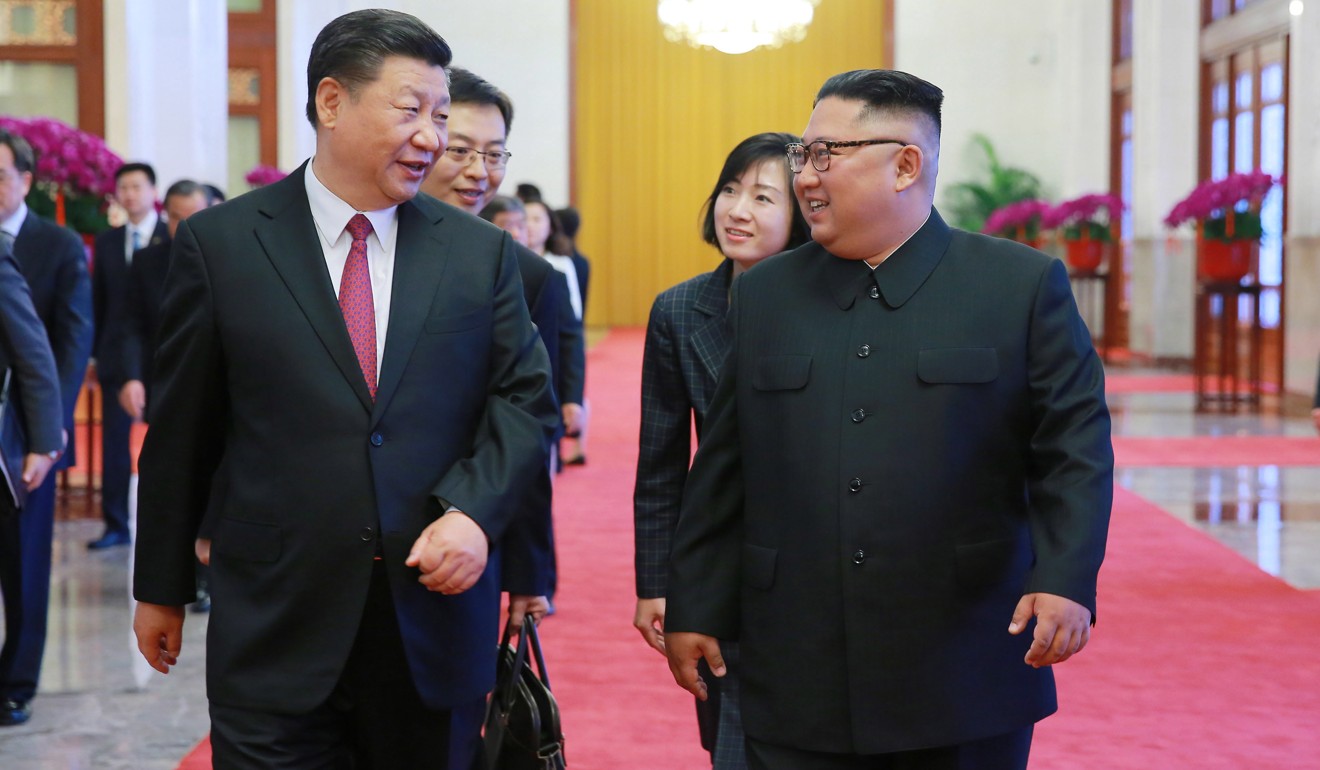
Kim Jong-un’s New Year’s speech offered no real surprises but one clear message from North Korea
- Edward Howell writes that Kim has expressed his readiness to meet with the US president again, but has also issued a warning about continuing sanctions
Kim Jong-un’s seventh New Year’s address was marked by visible changes in its format. Kim addressed the nation from a comfortable armchair, overlooked by portraits of Kim Il-sung and Kim Jong-il, one way of showing his connection to the North Korean population.
Optics aside, however, the message did not contain many surprises. Importantly, there was a clear message sent to the US, namely that the steps Washington takes in 2019 will be crucial in any development – positive or negative – on the nuclear issue.
Yet the North must also take steps itself, and we must not forget the relationship between Pyongyang and Beijing, one that has not always been amicable, not least in recent years.
The supreme leader affirmed his commitment towards an “independent socialist economy” as part of the five-year development plan put forth in 2016. Reaching out to the 25 million citizens in the DPRK, domestic goals of “relieving the shortage of electricity” and revitalising coal mining, fishing and light industries, would all aid “national prosperity and the people’s well-being.”
Amid the slogans of a socialist nation undergirded by the state ideology of juche (loosely translated as “self-reliance”), the focus on the domestic economy was nothing new. After all, this is part two of the byungjin policy of parallel nuclear and economic development, announced in March 2013, but what about the first?
Pyongyang perceives itself to be a fully fledged nuclear power, a declaration it did not shy away from announcing in April 2018 before the third inter-Korean summit, but also announced in December 2009, after the second nuclear test in May of that year, under Kim Jong-il.
Fast-forward less than 10 years, and in his New Year’s Day address, Kim Jong-un declared that the North “would neither make and test nuclear weapons any longer nor use and proliferate them.” This is an overt pledge – far more overt than Kim has stated previously – but whether this is a true signal of the North’s intentions remains unclear. An established nuclear power does not need to perform ongoing visible tests of its capabilities.
Moreover, while Kim stated how the North had “taken various practical measures” regarding the moratorium on future nuclear testing and production, there was no commitment to cap existing production of nuclear or fissile material. He reiterated the declaration’s call to “advance towards complete denuclearisation”, yet the gulf between the definitions of “denuclearisation” espoused by Pyongyang and Washington (and its allies), remains. The former calls for the removal of US security guarantee over the Korean peninsula (of note, US military presence), and the latter want a complete declaration and removal of North Korea’s nuclear weapons and fissile material.
The longer this divergence remains – and any actual progress on denuclearisation is stalled – the longer Pyongyang can keep buying time.
The address praised the rapprochement between the two Koreas witnessed in 2018 as a way of “revers[ing] inter-Korean relations in the utmost extremes of distrust and confrontation to those of trust and reconciliation.” Kim stressed his willingness to resume operations at the Kaesong Industrial Complex and Mount Kumgang tourist area “without any precondition”.
Economic development is high on the North’s agenda, but inter-Korean economic relations remain limited in scope by UN sanctions, and the nuclear problem remains unsolved.
Beyond the peninsula, the North’s key ally of China, with whom it engaged in continuing dialogue in 2018 with three visits by Kim to Beijing, was praised for “boosting strategic communication and traditional ties of friendship and cooperation”. Yet it not just talks between Washington and Pyongyang that have decelerated; those between Beijing and Pyongyang also lack direction.
A visit by North Korean Foreign Minister Ri Yong-ho to Beijing in early December aimed to strengthen the historic DPRK-PRC relationship, which has not always been as cordial as often expected. China has multiple considerations: its own status as a responsible great power, and its desire for the US and DPRK to put their differences aside and engage in a productive implementation of the statement that came out of the Singapore summit. This is no surprise, but at a time when the Beijing-Washington relationship is far from positive, will China step up its support for the North?
Despite China not committing itself to a traditional “alliance” with the North – instead emphasising its traditional “friendship” – China remains the North’s main trading partner, accounting for 90 per cent of the North’s trade. The PRC simultaneously remains committed towards encouraging the North’s denuclearisation, having supported (albeit reluctantly) UN Security Council sanctions on the state, but, together with Russia, has also called for softened sanctions.
Kim’s affirmation of the Pyongyang-Beijing relationship may be symbolic, but also strategic.

The call to China in his New Year’s address – and other socialist allies, including Cuba – may signal how 2019 will see not just the continuing of diplomacy between the US and South Korea (and the growing differences between these two allies on how best to deal with the North), but a growing attempt for Pyongyang to consolidate its friendships elsewhere, especially given the current political battles between China and the West.
Pyongyang must now juggle multiple balls: diplomatic momentum with the US and South Korea, coercing Washington into conceding on sanctions and pressure, and enhancing friendships with China, Vietnam and other socialist states.
Yet, diplomacy with a smile is not akin to tangible progress. It seems unlikely that China will take any drastic move to punish its “little brother” of the North, beyond what it has already done in 2018, but will keep up its calls for peace, denuclearisation and stability on the peninsula.
A second meeting between Kim and US President Donald Trump in 2019 seems likely, but will only make substantive progress if the summit statement does not echo of ambiguity, as was seen in Singapore.
Kim’s speech stated his readiness “to meet the US president again”, but he followed this with a warning to the US. If sanctions and pressure continue, the world should not be shocked if Pyongyang seeks to “find a new way for defending the sovereignty of the country”. When the threshold is crossed – whatever it may be – we may be back to the days of nuclear and missile testing.
The big question is when this threshold will be crossed. Although we know what happened in 2018, in the months following the New Year’s address, we should not be surprised if 2019 commences with somewhat less momentum.

